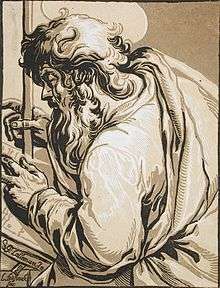Ludolph Büsinck


Ludolph Büsinck (c.1600–1669)[1] was a German painter and wood-engraver, born at Hann. Münden in the 1590s. He was working in Paris between 1623 and 1630, where he produced a series of chiaoscuro woodcuts, the first to be made in France [2] His name is sometimes spelled "Buesinck".
Life
Büsinck was born at Hann. Münden in central Germany between 1599 and 1602, a son of Johann Büsinck and his wife, Kunigunde Voss.[3] He married Katharina Ludwig, with whom, according to baptismal records, he had six children.[3] He may have trained as an artist in the Netherlands.[4]
Between 1623 and 1630 he is known to have been in Paris, where he made a number of dated chiaroscuro prints, some of which were published by Melchior Tavernier.[4] They are boldly cut works in the tradition of the Dutch printmaker Hendrick Goltzius.[5] He was the first artist to make chiaroscuro woodcuts in France, and most his works in this technique were based on drawings by the painter Georges Lallemand,[6] although one, probably his first, is after a painting by Abraham Bloemaert.[5] He is not known to have made any woodcuts after 1630.[4]
He returned to Hann. Münden, where he became a member of the merchants' guild (Kaufmannsgilde) in 1639. He is known to have been active as a painter in the 1630s, his works including an altarpiece for the high altar of the church of St John in Göttingen.[4] In 1647 he is recorded as acting as a customs official.[4]
He died at Münden on 15 January 1669.[4]
Works
His prints include religious subjects, and images of cavaliers, peasants, musicians and beggars.[2][4]
References
- ↑ Stechow, Wolfgang, "Catalogue of the Woodcuts by Ludolph Buesinck", Print Collectors Quarterly, October 1939, Vol. 26, No. 3, p. 349
- 1 2 Bryan 1886
- 1 2 Gealt, Adelheid M., Beyond Black & White: Chiaroscuro Prints from Indiana Collections, Indiana University Art Museum, 1989
- 1 2 3 4 5 6 7 Wegner, Wolfgang (1957). "Büsinck, Ludolph". Neue Deutsche Biographie. 3. p. 4.
- 1 2 Washton, Rose-Carol; Ward, John L. "The Seventeenth Century: Tradition and Experiment". Yale Art Gallery Bulletin. 27/28: 19–23. JSTOR 40514059.
- ↑ "St. Matthias, 1623–30". Cleveland Museum of Art. Retrieved 24 October 2013.
Bibliography
- Hollstein, F. W. H., Dutch And Flemish Etchings, Engravings And Woodcuts c. 1450–1700, Amsterdam, 1949
- Strauss, Walter L., Chiaroscuro: The Clair-Obscur Woodcuts By The German And Netherlandish Masters Of The XVI And XVII Centuries, London, Thames & Hudson, 1973
- Roethlisberger, Marcel G., Abraham Bloemaert and His Sons: Paintings And Prints, 2 vols., Ghent, 1993
- Stechow, Wolfgang, Ludolph Buesinck The Print Collector’s Quarterly 1938 Dec Vol. 25, No. 4, p. 393
- Stechow, Wolfgang, Catalogue of the Woodcuts by Ludolph Buesinck The Print Collector’s Quarterly 1939 Oct Vol. 26, No. 3, p. 349
External links
- www.artistarchive.com A catalogue of more than 35 prints by Büsinck with reference numbers, many with images.
References
